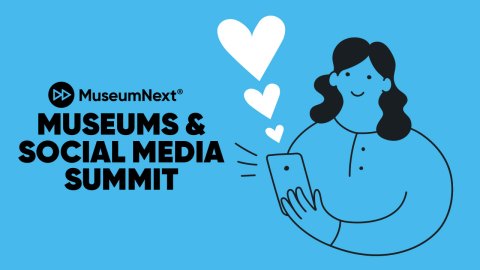
Even before joining the staff at AAM, I closely followed AAM’s ongoing work in the field of diversity, equity, accessibility, and inclusion. As a member of the Membership department here at the Alliance, I was excited to have the opportunity to join the Inclusion team and to collaborate on some great projects with some amazing staff. I believe that the work of diversity and inclusion should be an institution-wide effort, especially in outward-facing departments such as my own. Most recently in Membership, we’ve made a change to the prefix options available when signing up for a profile on our website. We’ve added the gender-neutral Mx. in addition to Mr., Mrs., Dr., etc., making it easier for our members to pick a title that best fits them. Please let us know if there is another option that you would like to see represented!
Last year, AAM’s Inclusion Team introduced a number of new offerings at the AAM Annual Meeting designed to create a more welcoming and inclusive environment for all attendees. This year, the Inclusion Team has led the effort to create a Code of Conduct for AAM events. I wanted to share some of the conversations we had writing the document and to do a deeper dive into some of the terms we use. I hope that this look into our collaborative process will be helpful in updating or planning your own code for meetings and events at your institution. We welcome your feedback in the comments below.
Why Have a Code of Conduct?
Our theme at the 2018 Annual Meeting is Educate, Engage, Elevate! Museums on the Rise. Our goal is to explore how museums are hubs of community activation and learning. At this year’s Annual Meeting, professionals will network, collaborate, discuss, and respond to issues that impact the educational ecosystem. These include immigration, criminal justice reform, economic inequality, LGBTQIA concerns, disability advocacy, and other sensitive issues. These discussions may not be easy, but with some guidelines in place, they can be productive and respectful.
Having a code of conduct creates a mutual sense of accountability at the Annual Meeting–both from our attendees and from us here at AAM. The code provides an easy-to-reference guide on what are expected behaviors. It also gives a reporting structure for any incidents that may occur. We’ve also clearly stated what consequences for violating the Code of Conduct look like.
In creating a code of conduct, our goal was to provide our participants with a “brave space,” a concept introduced to us by Sage Morgan-Hubbard, our own Ford W. Bell Fellow for Museums & P-12 Education. “Brave spaces” are places to freely discuss ideas, with a few guidelines in place to keep our interactions respectful and productive. We would never want to stifle discussions or infringe on free speech, but we had to find a way to protect the most vulnerable populations among us. In our Code of Conduct, we chose to focus on limiting behaviors that impact the freedom and safety of marginalized populations, rather than telling participants what opinions they are allowed to hold.
How Did AAM Get Started Writing a Code of Conduct?
We were able to build on a great foundation from other organizations. The Nonprofit Technology Conference has a great Code of Conduct, modeled on Geek Feminism’s code. We are grateful that Geek Feminism produced a how-to guide on producing an effective Code of Conduct that we were able to adapt to AAM’s needs.
After taking a look at other organizations’ codes, we had a brainstorming session to think about the type of environment we wanted to encourage at AAM’s meetings and events. Our goal remains to provide an environment safe for all participants. We strive to make sure that all of our events are free of discrimination and harassment. Through several meetings, we started to flesh out what behaviors we constituted to be discrimination and harassment. Some descriptions came really easily, such as “threats or acts of violence,” which is pretty clearly a harassing action. Other actions were more ambiguous and harder to describe.
So What Am I Not Allowed to Say?
Our Code of Conduct is not intended to limit free and open dialogue. It does place limits on what actions are acceptable at our meeting and events. For example, in our definition of harassment, we state that harassment includes “deliberate ‘outing’ of any person’s lived experiences or identity without their consent.” How does this work in practice? We recognize, for example, that on the subject of immigration, people hold complex and differing opinions, and that is fine. What is not acceptable is disclosing the immigration status of another person without their consent. This action endangers the safety of another person, and it is defined as harassment in our Code of Conduct.
We have included a section in our Code of Conduct that outlines what is not discrimination or harassment. It was hard to make the determination to include this section, as we did not want to place limitations on discussion or speech. However, we did want to make clear that persons placed in a defensive position based on their identity, lived experiences, or safety are not engaging in discriminating or harassing behavior when reasonably defending themselves or communicating boundaries. An easy way to conceptualize how this looks in practice is to consider the power dynamics in an interaction. For example, let’s say that two attendees who work in HR are expertly discussing racism in hiring practices as part of a group discussion. A third attendee contributes the comment “racism does not exist, businesses hire the most qualified people” and expects the other two to respond. The third attendee’s comment has the effect of derailing what was a fruitful discussion and places the two other attendees on the defensive to explain that racism does exist. For the two attendees to say to the third “we are not discussing this with you,” is a reasonable communication of boundaries. They are not being discriminatory against the third for refusal to debate a social justice issue.
In short, our Code of Conduct describes and limits the types of actions and behaviors that affect the safety of all participants at our annual meeting and other events.
I’m Unfamiliar with Some of These Terms. What does Deadname Mean?
In our Code of Conduct, there may be some phrases or concepts that you are unfamiliar with, and that’s fine! We are all here to learn. I’ve included definitions of key terms below for your reference. Please ask us if you need further explanation.
Throughout our drafting process, we struggled with how best to describe the various terms that people use to identify themselves. Grappling with this question of description required a lot of research and honest discussion on how to best name those identities. At first, we started with a list of specific identities (Black, Latinx, LGBTQIA, neuroatypical, Deaf, etc.). We soon realized that no matter how exhaustive the list, we would not cover all identities, nor would we would be able to list all the different words and terms people use to describe themselves.
To better encompass all people, we came up with the phrase, “a person’s lived experiences, identity, or safety.” Lived experiences means the first-hand accounts and impressions of living as a member of a minority or oppressed group. Identity refers to how a person would describe themselves. Safety means “the condition of being protected.” Using the phrase “comments or actions that minimize a person’s lived experiences, identity, or safety,” in our definition of harassment encompasses all of the richly diverse people that we aim to protect at our annual meeting.
Misgendering and deadnaming specifically refer to acts of harassment against trans and gender non-conforming people. To misgender means to intentionally use incorrect pronouns, for example referring to a “she” as a “they.” To deadname means to intentionally refer to a person by their pre-transition name. The experience of being deadnamed or misgendered is not only upsetting but can also be dangerous. Twenty-two states have no protections for trans workers, and many more have no housing protections or anti-hate-crime legislation for trans people. Being outed as trans can result in loss of income, housing, and exposure to violence.
Additionally, people change their names for all sorts of reasons that are not transition-related, such as marriage, divorce, faith, life experience, etc. If a person has changed their name, you need to respect that change! Please call people what they would like to be called. All attendees will have a name badge listing their preferred name, and pronoun ribbons are available at registration for those who wish to wear one.
Outing means to reveal sensitive information about a person without their consent. In many contexts, outing refers to the act of revealing someone is gay, lesbian, bisexual or transgender without their consent. In our definition of harassment, we have expanded the meaning of “outing” to include “lived experiences or identity.” This means that in our code of conduct, deliberately revealing sensitive and or private information about someone’s sexuality, gender, legal status, disability, etc. is an act of harassment.
What Does The Code of Conduct Look Like In Practice?
We are gathering in Phoenix because we believe that museums are centers for creativity and knowledge. Here at AAM, and in the field, we care about museums and how they impact the world. With our Code of Conduct, we aim to provide attendees and participants with the tools and information to encourage respectful, productive dialogues about the issues facing our field and our society. Please keep our Code of Conduct in mind as you participate.
I personally wish to thank all those who helped me craft and write this blog post, including (but not limited to):
Dr. Nicole Ivy (She, Her)
Brooke Leonard (She, Her)
Ember Farber (She, Her)
The AAM Inclusion Team









I look forward to Monday’s Open Forum. Here are two issues that might be useful to discuss:
1. What is the process by which violators of the code are to be expelled from the meeting, fined (by being denied a refund), and excluded from future events (who decides – a committee, a single AAM staffer?); are there any due process protections for someone accused?.
2. What are some additional examples of behavior that transgresses the code? Examples of respectful disagreement that are within the code? Knowing these would make everyone feel more assured in participating in robust and respectful professional discussions.
I share the committee’s wish to make everyone welcome and feel safe. Demeaning words and gestures can hurt and can silence voices that should be heard.
This is all very insulting to me personally. I have worked my hole life toward a museum career and every single topic discussed regarding diversity in the arts I have lived through. Who is going to hire me? Who is going to publish me? This is a bit of a joke compared to the comments and experiences I have heard and had. Nothing can give me back that wasted time.